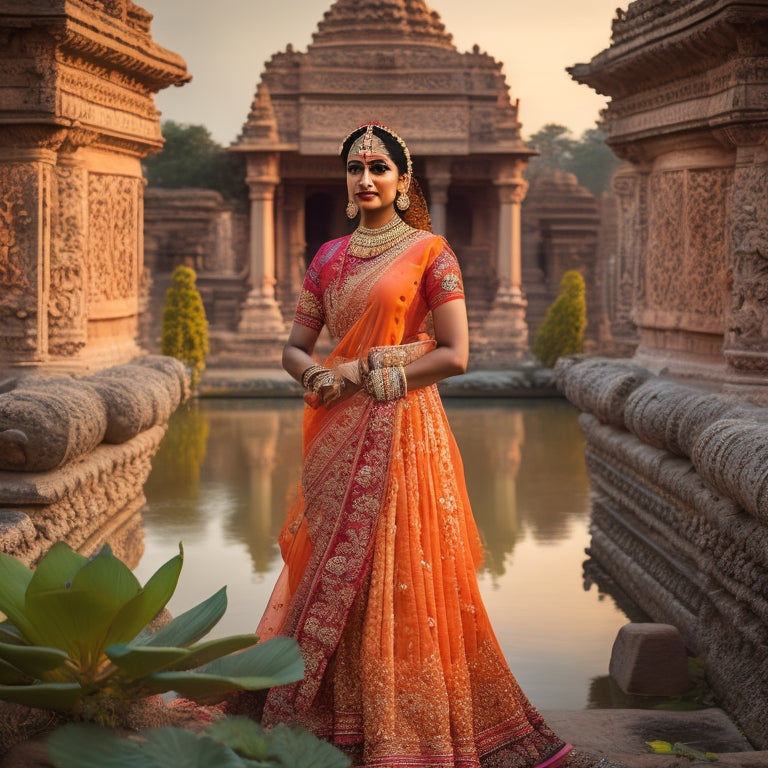
Kuchipudi Dance: Ancient Roots and Modern Preservation
Share
Kuchipudi, one of India's eight esteemed classical dance forms, boasts a rich cultural heritage rooted in ancient traditions, having evolved over time through the confluence of various influences. With origins tracing back to the Natyashastra and the Telugu Brahmin community, Kuchipudi has preserved its core principles while absorbing diverse cultural elements. This intricate dance form balances rhythmic foundation, expressive techniques, and emotional conveyance, showcasing skill and artistry through its repertoire. As India's cultural heritage continues to face modern challenges, the preservation of Kuchipudi dance remains a pressing concern, and exploring its multifaceted nature reveals the complexity of its ancient roots and modern significance.
Key Takeaways
• Kuchipudi Dance originates from Natyashastra and the Telugu Brahmin community's Bhagavathalu traditions, with influences absorbed over time.
• The dance form is rooted in core principles like Tala, Layam, Abhinaya, Rasa, and Natya, Lasya, and Tandava, ensuring aesthetic appeal.
• Elaborate costumes and makeup enhance the dramatic impact of performances, reflecting characters' personalities and social status.
• The diverse repertoire includes Varnam, Tillana, Padam, Javali, and Sabdam, showcasing skill, artistry, and mastery of rhythm, expression, and narrative.
• Preservation efforts involve documentation, institutional support, community engagement, and safeguarding traditional practices to conserve India's cultural heritage.
Ancient Roots of Kuchipudi Dance
With its origins deeply rooted in the ancient Indian tradition of Natyashastra, Kuchipudi dance has a rich cultural heritage that has been refined over the centuries. The Natyashastra influence is evident in the dance form's emphasis on dramatic expression and storytelling.
Kuchipudi's Bhagavathalu origins are attributed to the Telugu Brahmin community, who practiced this art form as a devotion to Lord Krishna. Over time, the dance form evolved, absorbing various cultural influences, yet remaining true to its core principles.
The ancient roots of Kuchipudi have been carefully preserved and passed down through generations, ensuring the dance form's continued relevance and beauty. This rich cultural legacy has enabled Kuchipudi to thrive, earning its place as a revered classical dance form of India.
Principles and Elements of Kuchipudi
Building upon its ancient roots, Kuchipudi's aesthetic appeal and expressive power are rooted in a set of core principles and elements that govern the dance form's technical and artistic execution.
The dance form's rhythmic foundation is established through Tala and Layam, which provide the framework for rhythm and tempo.
Abhinaya techniques, meanwhile, facilitate expression through gestures, allowing dancers to convey nuanced emotions and narratives.
The Rasa expressions, a key component of Kuchipudi, enable dancers to convey the nine primary emotions, ranging from love to fury.
Additionally, the principles of Natya, Lasya, and Tandava ensure a balance between storytelling, grace, and energetic movements.
Costumes and Makeup in Performance
In Kuchipudi performances, the elaborate and vibrant costumes, replete with intricate designs and ornaments, serve as an integral component of the dance form, elevating the overall aesthetic appeal and reinforcing the emotional narrative. The colorful attire not only adds visual beauty to the performance but also enhances the expressive gestures of the dancers, allowing them to convey emotions more effectively.
The intricately designed costumes are often adorned with ornaments that reflect the character's personality and social status, adding depth to the storytelling.
The makeup is carefully crafted to highlight the dancer's expressions, making their emotions more palpable to the audience.
The combination of costumes and makeup creates a harmonious balance, elevating the overall dramatic impact of the performance.
Compositions and Repertoire of Kuchipudi
Characterized by their technical complexity and emotional depth, Kuchipudi compositions comprise a diverse repertoire of pieces that showcase the dancer's skill, expression, and artistry.
Traditional choreography is rooted in ancient texts, while musical accompaniment provides a rich sonic landscape.
The repertoire includes the Varnam, a complex and elaborate centrepiece, the Tillana, which showcases skill and agility, and the Padam, which expresses emotions through gestures.
The Javali and Sabdam complete the repertoire, offering light-hearted and playful themes, and a combination of pure dance and storytelling, respectively.
These compositions demonstrate the dancer's mastery of rhythm, expression, and narrative, underscoring the richness and diversity of Kuchipudi's musical and choreographic heritage.
Preserving India's Cultural Heritage
As Kuchipudi's rich repertoire and intricate compositions demonstrate the art form's significance, the preservation of India's cultural heritage becomes a pressing concern, necessitating efforts to safeguard this valuable legacy for future generations.
Cultural conservation requires a multifaceted approach to protect traditional practices and ensure their sustained relevance.
-
Documentation and archiving: Recording and preserving Kuchipudi's history, techniques, and compositions for future reference.
-
Institutional support: Establishing and supporting institutions dedicated to promoting and preserving classical dances like Kuchipudi.
-
Community engagement: Encouraging community involvement and participation in cultural conservation efforts to foster a sense of ownership and responsibility.
Frequently Asked Questions
How Does Kuchipudi Dance Incorporate Storytelling Into Performances?
Kuchipudi dance masterfully incorporates storytelling through expressive movements, intricate footwork, and symbolic gestures, which, when combined with traditional costumes, convey nuanced emotions and narratives, bringing ancient tales to life in a mesmerizing display of artistry.
What Is the Significance of the Kuchipudi Art Academy in Dance History?
The establishment of the Kuchipudi Art Academy in 1958 was a watershed moment, revolutionizing the dance form's historical impact and cementing its cultural preservation, thereby safeguarding India's rich artistic heritage for generations to come.
Are Kuchipudi Dancers Required to Undergo Rigorous Training Programs?
Kuchipudi dancers must undergo rigorous training programs, entailing intensive practice and mastery of traditional techniques, to perfect the intricate gestures, expressions, and footwork that define this classical dance form, ensuring preservation of its rich cultural heritage.
Can Kuchipudi Be Performed to Different Types of Music or Rhythms?
As the gramophone's nostalgic crackle fades, the question arises: can kuchipudi adapt to diverse musical landscapes? Indeed, this ancient dance form can evolve through musical adaptations, embracing cultural diversity, while experimenting with rhythmic variations that balance traditional essence with contemporary flair.
Are There Any Modern Fusions of Kuchipudi With Other Dance Styles?
Modern fusions of Kuchipudi with other dance styles have led to innovative fusion collaborations, blending traditional techniques with contemporary interpretations, resulting in unique and dynamic expressions that expand the dance form's boundaries.
Related Posts
-

Dance Bags for Every Style and Budget
You need a dance bag that mirrors your unique style while staying within your budget, and there's plenty to choose fr...
-

Design Costumes Like a Pro in 5 Essential Steps
To design costumes like a pro, start by upcycling materials and exploring thrift stores for hidden gems. Next, welcom...
-

What Are the Most Popular Contemporary Costumes Right Now
Right now, popular contemporary costumes blend creativity with current trends, allowing you to showcase your unique f...


